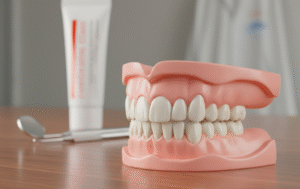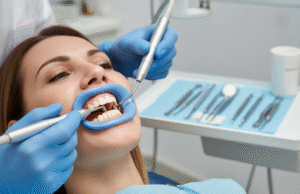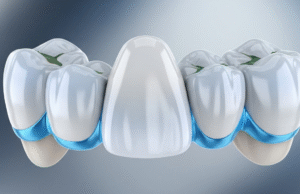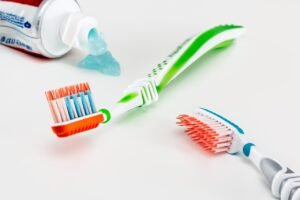Tooth loss in the bottom front area can significantly impact both appearance and functionality. Whether due to injury, decay, or gum disease, missing lower front teeth can affect chewing, speaking, and self-confidence. Fortunately, lower partial dentures offer an effective solution by restoring both function and aesthetics while preventing further dental issues.
In this comprehensive guide, we’ll cover everything you need to know about lower partial dentures for bottom front teeth, including their types, benefits, care tips, and potential challenges.
What Are Lower Partial Dentures for Bottom Front Teeth?
Lower partial dentures are custom-made removable prosthetics designed to replace one or more missing front teeth on the lower arch. Unlike full dentures, which replace an entire set of teeth, partial dentures attach to existing natural teeth using clasps or precision attachments.
These dentures fill in the gap left by missing teeth while maintaining the natural alignment of surrounding teeth. They are made from materials like acrylic, metal, or flexible resin, each offering different levels of comfort and durability.
Benefits of Lower Partial Dentures for Bottom Front Teeth
✔ Restores Appearance – Missing bottom front teeth can make a person self-conscious. Partial dentures help restore a natural-looking smile.
✔ Improves Speech – The absence of front teeth can cause speech difficulties. Dentures help in clear pronunciation.
✔ Enhances Chewing Ability – Lower partial dentures allow for better chewing and biting function, making eating more comfortable.
✔ Prevents Teeth Shifting – When a tooth is lost, the surrounding teeth can drift into the empty space. A partial denture keeps them aligned.
✔ Affordable Alternative to Implants – Partial dentures are more cost-effective than dental implants while still providing excellent functionality and aesthetics.
Types of Lower Partial Dentures for Bottom Front Teeth
There are several types of partial dentures, each with unique advantages.
1. Acrylic Partial Dentures
✔ Made from acrylic resin with artificial teeth attached.
✔ Often used as a temporary or cost-effective option.
✔ Held in place with metal clasps that grip onto existing teeth.
2. Metal Framework Partial Dentures
✔ Built with a thin, durable metal base for extra strength.
✔ Less bulky and more comfortable than acrylic dentures.
✔ Provides a stable and secure fit due to strong metal clasps.
3. Flexible Partial Dentures
✔ Made from lightweight and flexible nylon or resin.
✔ No visible metal clasps, making them more discreet.
✔ Ideal for people with sensitive gums or those seeking aesthetic appeal.
Each type of lower partial denture has its pros and cons. The choice depends on factors such as comfort, durability, and budget.
How to Adjust to Lower Partial Dentures
Getting used to lower partial dentures can take time. Here are some tips to ease the transition:
✔ Start with Soft Foods – Initially, eat soft foods and gradually transition to harder foods.
✔ Practice Speaking – Read aloud or practice pronouncing difficult words to adjust to speech changes.
✔ Wear Consistently – The more you wear them, the faster your mouth adapts.
✔ Remove at Night – Taking them out before bed helps your gums rest.
✔ Use a Denture Adhesive (If Needed) – Some people find extra stability with adhesive, but it should be used as directed.
Cleaning and Maintenance of Lower Partial Dentures
To ensure longevity and good oral hygiene, proper care is essential.
✔ Daily Cleaning – Brush dentures with a soft-bristle toothbrush and a denture-safe cleaner (avoid regular toothpaste).
✔ Soak Overnight – Keep dentures in a moisturizing solution to prevent drying out.
✔ Rinse After Eating – Remove food particles and bacteria buildup by rinsing your dentures.
✔ Handle With Care – Avoid dropping them, as they can break or crack.
✔ Schedule Regular Checkups – Visit a dentist regularly to ensure proper fit and adjustments.
Common Challenges and Solutions
Some users may experience minor discomfort at first, but most issues can be resolved with proper adjustments:
🔴 Sore Gums – If the denture rubs against your gums, a dental adjustment may be necessary.
🔴 Difficulty Speaking – Speech may feel different at first, but regular practice helps adjust quickly.
🔴 Loose Fit – Over time, bone and gum changes may require a denture reline or replacement.
🔴 Excess Saliva Production – This is common when you first start wearing dentures but subsides after a few days.
🔴 Chewing Challenges – Start with soft foods and gradually add harder textures.
If discomfort persists, a dental consultation is recommended.
Hummingbird Dental: Richmond Hill’s Leading Emergency Dental Clinic
When a dental emergency strikes in Richmond Hill, Hummingbird Dental is the clinic you can count on for immediate, high-quality care. Located at 10376 Yonge St #202, Richmond Hill, ON L4C 3B8, Hummingbird Dental is renowned for its responsive and compassionate approach to emergency dental situations. Whether it’s a sudden injury, a painful toothache, or a dental issue that needs urgent attention, the experienced team at Hummingbird Dental is ready to help.
Contact Hummingbird Dental at +1 647-370-2024 or via email at info@hummingbirddental.ca to receive the emergency dental care you need. Their team is dedicated to providing quick and effective treatment to alleviate pain and protect your oral health.
FAQs About Lower Partial Dentures for Bottom Front Teeth
1. How long does it take to adjust to lower partial dentures?
Most people adjust within a few weeks. At first, it may feel bulky, but over time, you will become more comfortable wearing and using it.
2. Can I eat normally with lower partial dentures?
Yes! However, you should start with soft foods and gradually introduce harder foods as you get used to the denture. Avoid very sticky or hard foods that could damage it.
3. How long do lower partial dentures last?
Partial dentures can last several years with proper care, but they may need adjustments due to gum and bone changes. Regular dental visits help determine when relines or replacements are needed.
4. Will partial dentures affect my speech?
Initially, you might experience minor speech changes, but practicing pronunciation and speaking slowly helps you adjust quickly.
5. Can I sleep with my partial dentures in?
It’s recommended to remove them at night to let your gums rest and heal. Keeping them out also reduces the risk of bacteria buildup.
Conclusion
Lower partial dentures for bottom front teeth are an excellent solution for individuals who have lost one or more front teeth. They restore functionality, improve speech, enhance aesthetics, and prevent further oral health issues.
With options like acrylic, metal, and flexible partial dentures, patients can choose the best fit for their needs. Though it takes time to adjust, proper care and maintenance ensure long-lasting comfort and durability.
If you’re considering lower partial dentures, consulting a dental professional can help determine the best option for your specific needs.










